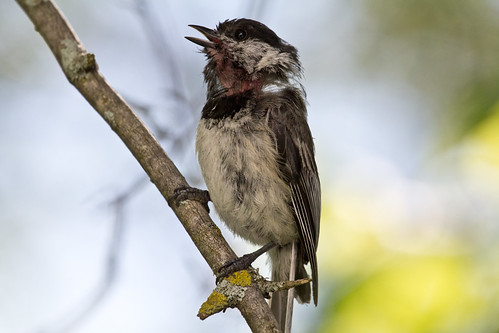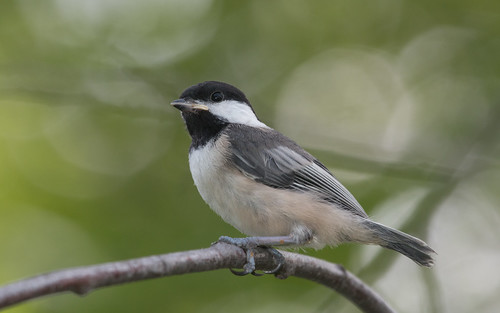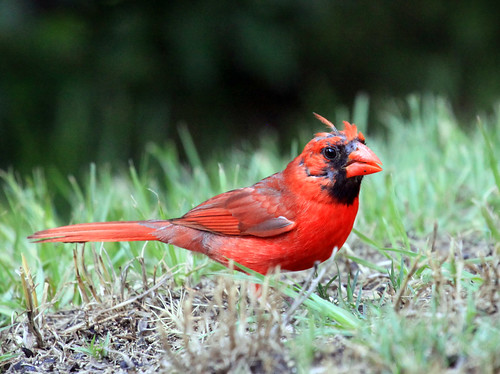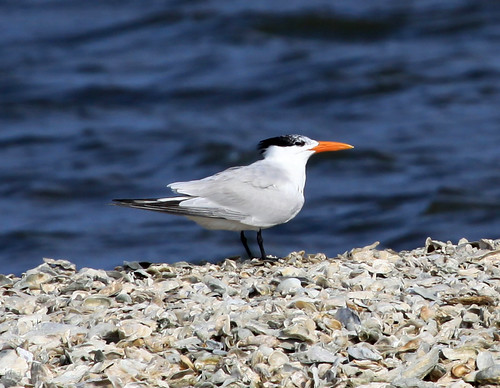Those benefits exact a cost—feathers degrade and wear out with time, so all bird species replace their body and flight feathers periodically in a process we call molt. Many of our songbirds molt just once a year. Chickadees time this molt for summer after the young no longer depend on the adults. Adult chickadees wearing their year-old feathers are run ragged by their chicks. By mid-summer, some look extraordinarily bedraggled and even pathetic, especially compared with their fledglings, wearing spanking new feathers.
But soon all those worn out adult feathers will be pushed out by new ones, leaving the adults in fine fettle before the coming winter. Most birders call the new body feathers molted into in late summer basic plumage.
Some songbirds have a second partial molt each year, replacing their body feathers before the breeding season. We can watch goldfinches make the transition from dull winter plumage to bright spring plumage—as they molt, their body feathers look very patchy. If we were in the tropics, we could observe tanagers go through that same patchy process before they head up here for the breeding season. The feathers giving this different appearance for the breeding season are called the alternate plumage.
Some birds manage to enhance or change their appearance before the breeding season while only molting once, in late summer. In the brand new feathers of their basic plumage, a Northern Cardinal's body feathers are edged with brown, giving them a dullish look in late summer and early winter. Those feather edges improve insulation and weather proofing at least a bit during the coldest season, but by winter’s end are wearing off so that the more brilliant part of the feather is exposed, giving the male his most spectacularly red plumage right when he needs it.
Timing the molt for summer’s end is ideal for many of our eastern songbirds, which have plenty of food resources in mid-late summer, right when they’re done with egg production and all the high-energy costs of incubating those eggs and raising young. As temperatures start dropping in fall, most songbirds grow additional down feathers in preparation for winter, but these inner feathers don’t change their appearance at all. For example, redpoll feathers weigh 31 percent more in winter than in summer because of this increase.
No bird drops all its body feathers at once during molt—new feathers push the old ones out little by little. Oddly enough, some individual jays and cardinals do seem to molt all their head feathers at once.
The sturdy wing and tail feathers are lost and replaced in sequence. These feathers must be pretty much perfect to support the bird in flight, so some birds replace only some of them each year. With a close look or a look under a black light at a bird such as an owl in hand, bird banders can identify which feathers are fresh and which are faded to figure out how many times a bird has replaced these feathers, providing a solid guess about the bird’s age.
Loons and some other species that are exceedingly heavy relative to their wing size can’t afford to lose any flight feathers from spring migration through fall migration—any reduction in wing surface area impairs their ability to fly. This is why loons molt all their wing feathers simultaneously while they’re on the ocean in winter. They can swim anywhere they need to find food during the weeks when they’re unable to fly, and will have fresh, sturdy new feathers by the time they head back to their freshwater breeding lakes.
Right now I’m thinking about molting birds because Lisa Johnson has been taking photos of American White Pelicans this summer. These birds live up to their name—their adult plumage is white with gleaming black flight feathers. But weirdly, breeding adults in summer grow patchy black feathers on their crown, nape, and along the back of their necks.
The pattern of these black feathers varies crazily from one bird to another, and there is no consensus on what to call them or whether it’s a true molt that produces them, or if they’re produced by either an early part of basic molt or a delayed part of an alternate molt. Most people just call this supplemental plumage. But since the odd feathers are found primarily on the top of the head, Lisa decided to call them a toupee, which seems as accurate and descriptive as anything ornithologists have come up with.
This pelican toupee grows in during the nesting season, at the same point in the nesting cycle that Royal, Elegant, and Sandwich Terns of the coasts are molting into dark head spotting that also varies widely among individuals.
In these terns and the American White Pelican, the young gather into large groups called crèches, quite similar to what young sea ducks, mergansers, and geese form. But baby waterfowl feed themselves—they can follow any adult to a good feeding spot. Pelican and tern chicks depend on their parents to bring food and feed them. These chicks may memorize the unique spotting on their parents' heads during their time in the nest so they can recognize their parents when they join these crèches.
A lot of birders put away their binoculars in summer as birds stop singing, grow secretive to raise their young, and look most bedraggled. For me, summer is when birding grows the most interesting, when we get fascinating glimpses into avian family life as well as peculiar things like bald jays and toupee-wearing pelicans. A year of bird watching is best enjoyed all in good time. For the most aware birders, every moment of every day, it's all a good time.







